From 9 June to 20 September 2009 the Museo Thyssen-Bornemisza presented the exhibition Matisse: 1917-1941, comprising a survey of the artist’s work during the central period of his career. 74 paintings, sculptures and drawings, most of which have never been previously exhibited in Spain, were loaned from about fifty museums and collections world-wide.
Matisse: 1917-1941 aimed to analyse Matisse’s work over a lengthy period that has until now been of less scholarly interest than the start and end of his career. Marked by the shadow of World War I and the forebodings of the next world war, for modern art this was a period of rapid ascent and growing public acceptance. Together with Picasso, Matisse occupied a central role in this flourishing period and it was precisely in order to attain this position that he decided to move away from Paris, isolate himself in Nice, and submerge himself in a systematic process of research of the characteristics of the new painting.
1917 and 1941: two key dates in the life and career of Matisse
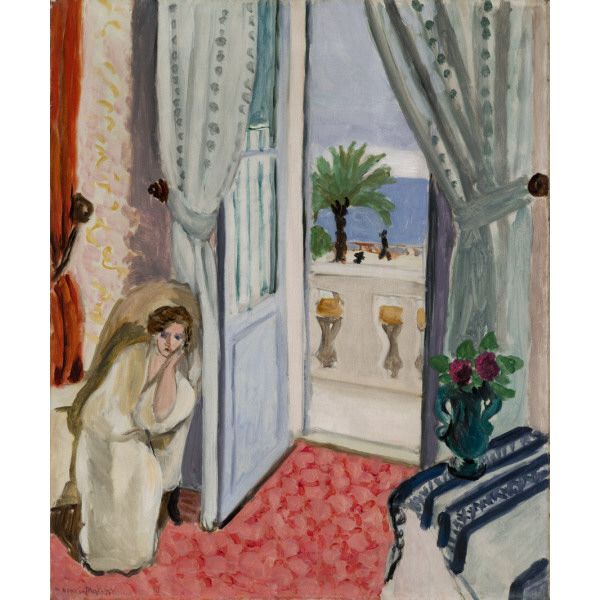
Interior at Nice c. 1919 St. Louis Art Museum
In 1917 Matisse signed a new contract with his gallery, Bernheim-Jeune. At that moment the end of the war was in sight and it was evident that the artistic scene prior to the war, based around the early avant-garde movements, had disappeared and would never return. For Matisse, the war had resulted in the loss of his Russian clients for whom he had previously worked for more than a decade. The large-scale canvases that he had painted for them (such as The Dance of 1909-1910) had been conceived for specific architectural settings and the artistic issues that they involved were similar to those of mural painting (like that of Giotto, an example whom Matisse aimed to follow). Now, by contrast, in order to direct himself at the anonymous public who would be the potential collectors of modern art, he was obliged to shift his field of investigation into that of easel painting. It was in order to embark on this undertaking that he moved to Nice, a city in the south of France that was sufficiently far from Paris, as well as enjoying optimum conditions of natural light and an agreeable climate.
Images
.+Interior+with+a+Violin+Case,+1918-1919..jpg)
Interior with a Violin Case, 1918-1919. The Museum of Modern Art, Nueva York. L.P. Bliss Collection, 1934.
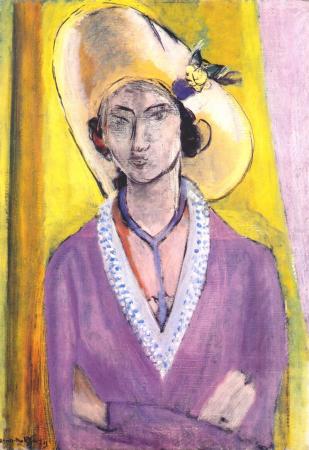
The Yellow Hat, 1929. Pierre and Tana Matisse Foundation Collection.
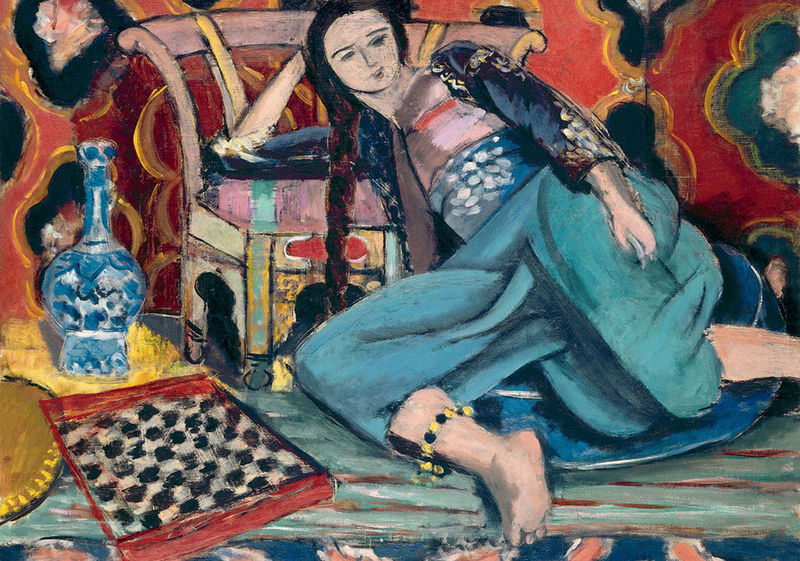
Odalisque with a Turkish Chair, 1927-1928. Musée d’Art Moderne de la Ville de Paris.
With this return to easel painting, Matisse’s interest in its historical precedents was revived, primarily through the work of the Impressionists, but also through that of Manet, Courbet, Chardin, Rembrandt and Vermeer. The attraction of Islamic decorative art, which had played a key role in his pre-war mural paintings, now led him towards an Orientalism that explicitly involved the influence of Ingres and Delacroix. As in his previous period, in this new phase Matisse continued to focus his attention on the essential resources of the pictorial idiom. Firstly colour, as this was the area in which he felt most comfortable, and line, on which he increasingly concentrated his efforts and whose study he complemented with the practice of sculpture. At the same time this new period of reflection increasingly led him to consolidate a formalist aesthetic (as was the case with many other creative figures of this period such as Bonnard, Morandi, Valery and Montale), inspired by a reading of the two founding poets of modernity, Baudelaire and Mallarmé, and focused on the idea of the autonomy of art in relation to life and that of form in relation to emotion.
Nonetheless, as the years passed, the uncertainties and isolation implied by this quest weighed ever more on Matisse and from 1927 his output decreased. In order to emerge from this crisis in 1930 he undertook a lengthy trip to Tahiti during which he practically ceased to paint. After this he received a new mural commission from Alfred Barnes, an American businessman who had assembled a unique collection of Impressionist and modern paintings in which Matisse occupied a central position along with Cézanne and Renoir. For this new commission Matisse decided to return to the theme of The Dance of 1909-1910, although now translated into a more epic, abstract mode. This project involved more than three years’ work.
By the time Matisse returned to easel painting in 1934 the modern art market had practically disappeared in Europe due to the economic crisis of 1929, while the political and historical conditions that had previously encouraged it had also deteriorated. This decline was accelerated by the rise to power of Hitler in Germany, the outbreak of the Spanish Civil War, and finally World War II. When the Germans occupied France in 1941 and the Petain government accepted the armistice, Matisse, in contrast to other modern artists and writers who emigrated to the US, decided to remain in Nice. In the meantime his health deteriorated and he was obliged to undergo an operation that almost resulted in his death. Matisse never fully recovered, but his illness did not prevent him from submerging himself once more in his work, concentrating on an admirable series of drawings that he entitled Themes and Variations, which were executed in extreme isolation. The present exhibition concludes with this undertaking, which marks the end of the central period of Matisse’s career in which painting prevailed, before the onset of a new phase characterized by his paper cut-outs.
The exhibition was organized into the following sections:
1. Painting and Time
This brought together paintings executed during Matisse’s early years in Nice. One of the prevailing themes is that of the window, a motif that had been considered a paradigm of painting itself since the Renaissance. In addition, music (referred to through the violin, an instrument that Matisse enjoyed playing) is presented as a reflection on artistic creation. The light of southern France reflected on the sea illuminates a room, sometimes empty or occupied by remote female figures in repose. Their crystalline tranquility echoes the painting of Vermeer.
2. Landscapes, Balconies and Gardens
The exhibition continued with a room devoted to the exploration of exterior space through paintings of landscapes and gardens, sometimes seen from above, from a balcony or window. The use of distance emphasises the artificiality of artistic creation, the insurmountable barrier that separates art from life.
3. Intimacy and Ornament
In the third section a number of still lives were juxtaposed with interiors painted with the doors or windows closed. The models are sometimes seen deep in thought or sleeping. Flowers, mirrors, silks and jewels attract the viewer’s gaze. The arabesque of the brushstroke conceals desire, prostration or sadness.
4. Background and Figure
Increasingly focused on the human figure, Matisse’s pictorial quest settled on the issue of its representation in relation to the background against which we see it. As had been the case in the first decade of the century (Blue Nude, Recollection of Biskra, 1907) Matisse looked to Michelangelo, and in some of his paintings of interiors we can detect the white outline of the Dying Slave. The weight and volume of the figure and its solidity counteract the two-dimensionality of an oppressive background. The artist returned to his reflection on Islamic art (textiles), which had been crucial to his work since the first decade of the 20th century.

Conversation Under the Olive Trees, 1921. Colección Carmen Thyssen-Bornemisza on deposito in the Museo Thyssen-Bornemisza de Madrid.

The Inatentive Reader, 1919. Tate: Bequeathed by Montague Shearman through the Contemporary Art Society 1940. Interior with a Violin, 1917-1918.

The Moorish Screen, 1921. Statens Museum for Kunst, Copehhage. J. Rump Collection Philadelphia Museum of Art. Bequest of Lisa Norris Elkins, 1950.
5. Form. The Nude
The female nude was the principal focus of Matisse’s attention. For the artist it was the mirror that helped him to study all the issues of painting and the very paradigm of its form (and of the beauty to which it aspires). Matisse studied the female nude in a systematic way, in painting, drawing and sculpture, and he used the same variants to be found in the work of the classical Greek sculptors: lying down, seated or standing. Matisse caused surprise when he frequently disguised his real quest with the use of absurd, tacked-on costumes, but beneath this persistent endeavour lay a growing restlessness and dissatisfaction.
In 1930, with the commission of a large mural painting for the Barnes Foundation, his register abruptly changed. From the lyrical tone of his domestic interiors, Matisse jumped to the opposite extreme of the monumental, heroic nude. This jump leads us on to a situation dominated by tension between two polarities: the static nude takes shape sculpturally in Nude seen from behind IV (1931), while the painted nude in movement is expressed in The Dance for the Barnes Foundation.
6. Une sonore vaine et monotone ligne
In the second half of the 1930s while darkness fell around him, Matisse became ever more isolated and focused increasingly on painting. He returned to easel painting although allowing himself to be influenced by the abstraction that he had achieved in The Dance for the Barnes Foundation and in Nude seen from behind IV. His figures seem ever more self-absorbed, nocturnal and unobtainable. The colour becomes increasingly weightless and the form is reduced to line or to a flowing sign: “Une sonore, vaine et monotone ligne” (a monotonous, vacuous and resonant line), in the words of a line from L’après-midi d’un faune. Matisse, who took Mallarmé’s poem in the first decade of the century as the subject for one of his finest mural paintings and illustrated it in a book of 1930, returned to this theme from 1935 onwards in a large-format painting that remained unfinished. The drawings that the artist grouped together under the title Theme and Variations (1942) thus constitute the end of this period and of the exhibition.
More Images from Exhibition:

Henri Matisse, Still Life with a Sleeping Woman, 1939-1940. National Gallery of Art, Washington. Mr. and Mrs. Paul Mellon Collection.
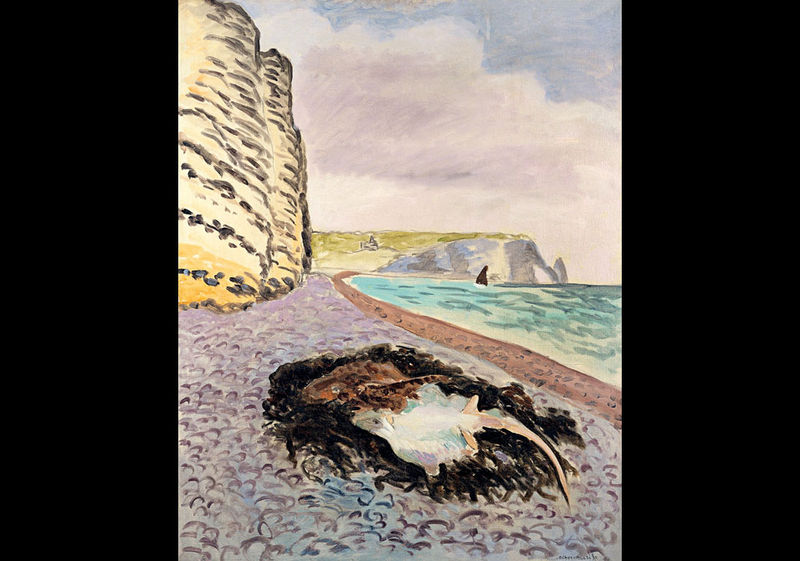
Henri Matisse, Large Cliff: the Two Rays, 1920. Oil on canvas, 92,7 x 73,7 cm. Norton Museum of Art, West Palm Beach, Florida.

Henri Matisse, Interior with a Violin, 1918. Oil on canvas, 116 x 89 cm. Statens Museum for Kunst, Copenhagen.
,++Young+Woman+on+a+Divan.+Black+Ribbon,+1922.++Nahmad+Collection,+Switzerland..jpg)
Henri Matisse, Young Woman on a Divan. Black Ribbon, 1922. Oil on canvas, 47 x 56,1 cm. Nahmad Collection, Switzerland.

Henri Matisse, Young Women in the Garden, 1919. Oil on canvas, 54,5 x 65 cm. Musée des Beaux-Arts La Chaux-de-Fonds, Switzerland.
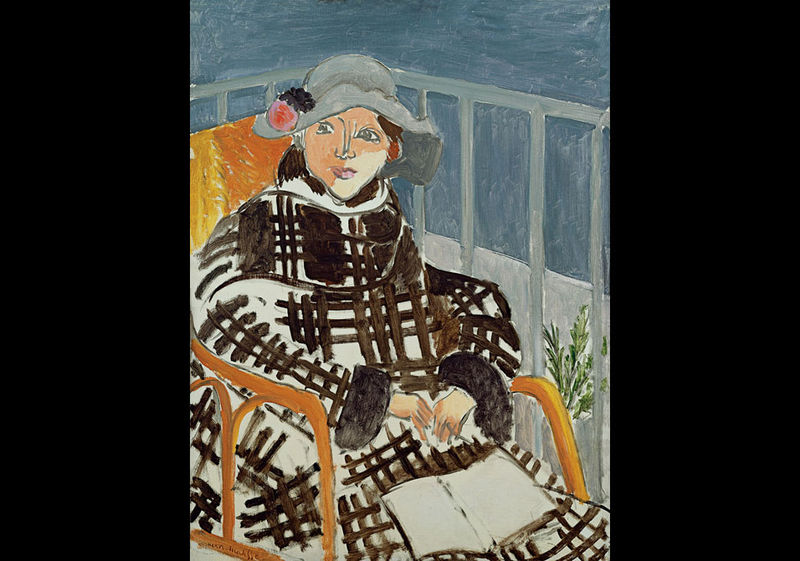
Henri Matisse, Mlle. Matisse in a Scottish Plaid Coat, 1918. Oil on canvas, 95 x 75 cm. Mr. y Mrs. A. Alfred Taubman Collection.

Henri Matisse, Odlisque with a Tambourine, 1925-1926. Oil on canvas, 74,3 x 55,6 cm. The Museum of Modern Art, New York.
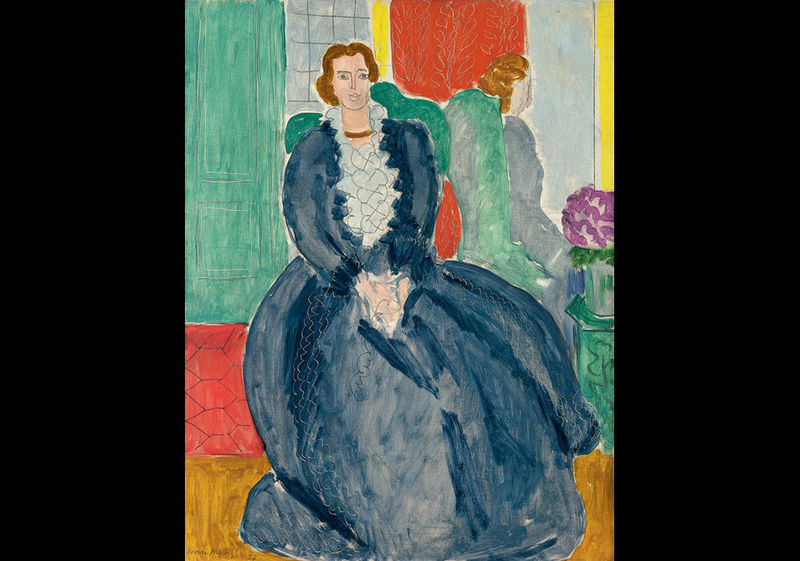
Henri Matisse, Small Blue Dress before a Mirror, 1937. Oil on canvas, 64 x 49 cm. The National Museum of Modern Art, Kyoto.

















